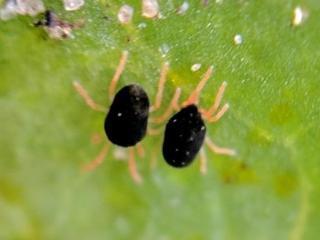Spring control of redlegged earth mites
Spring has sprung and growers and consultants are reminded to monitor for redlegged earth mites (RLEM) in pastures and to find out their specific Timerite® spring spray date if spraying is necessary.
The timing of the sprays is based on a short window of the season when RLEM have stopped laying winter eggs (eggs that must hatch this season) and before they start laying diapause eggs (over-summering eggs able to survive until next autumn).
Controlling mites at this time means that the whole population can be reduced, leaving few mites to carry-over to the following autumn.
Growers who have not already obtained their spray date that is specific to their locality can do so (free of charge) from the Australian Wool Innovation (AWI) Limited Helpline on 1800 070 099 or you can type the latitude and longitude of your property into the AWI TIMERITE® page to obtain your spray date and other useful information.
Please note that the Timerite® date does not work against blue oat mite nor lucerne flea.
Studies by CSIRO have shown that spraying up to two weeks earlier or on the optimum spray date provides effective control of RLEM, however if spraying is delayed by two weeks after the optimum date the carry-over RLEM population into next autumn is much higher.
Farmers intending to spray paddocks should make the most of suitable weather conditions to go early or on time, rather than later than the predicted Timerite® date.
Growers are advised to spray only if they need to and to rotate chemical groups to stop resistance developing in RLEM. Repeated use of synthetic pyrethroid insecticides or organophosphate insecticides such as omethoate and chlorpyrifos provides strong selection pressure for RLEM to develop resistance.
For more information on applying integrated pest management strategies when managing RLEM refer to GRDC’s Resistance management strategy for the redlegged earth mite in Australian grains and pastures fact sheet.
Growers who find RLEM that survive registered rates of insecticide treatments are encouraged to arrange for resistance testing to be conducted by contacting DPIRD entomologist Svetlana Micic, Albany on +61 (0)8 9892 8591 or 0427 772 051. The free-of-charge service, made possible with investment by the Grains Research and Development Corporation (GRDC), is led by The University of Melbourne, in collaboration with DPIRD, Cesar Australia and CSIRO.
Grazing reduces mite carryover in pastures
The level of grazing and quantity of pasture feed on offer (FOO) is directly related to the numbers of RLEM. Department grazing trials have shown that pasture grazed to 1.4t/ha FOO during spring will have low levels of mites, equivalent to numbers after spraying pastures with high FOO level.
Spraying of pastures in spring will have little or no benefit where pasture FOO levels are kept low by grazing. Insecticides applied to control RLEM in spring pastures or legume break crops with FOO levels greater than 3t/ha will reduce their numbers and provide benefits by allowing increased spring growth and seed set and a much reduced potential for RLEM carry-over into next autumn.
However, increased production benefits can largely be wasted unless the increased feed is utilised by strategic grazing management or fodder conservation. It is recommended that farmers should not spray all pasture paddocks but rather select paddocks for spring spraying based on FOO levels, future grazing feed management, level of required seed production and intended paddock use next autumn.
Redlegged earth mite survey
Cesar Australia is conducting a national survey on redlegged earth mite. Your responses will help to increase understanding of current control strategies and to improve how the redlegged earth mite is managed across Australia. It only takes 10 minutes to complete the survey.
To thank you for your time, all survey participants will be given early access to module one of Cesar Australia’s redlegged earth mite online training which covers identification, distribution, host range and damage.
The survey is being led by Cesar Australia as part of a GRDC investment (CES2010-001RTX), which has been extended to red meat producers through co- investment from Meat and Livestock Australia and to pasture seed producers through co-investment from AgriFutures Pasture Seeds Program (PRJ-013101). The wider project involves contributions from the Department of Primary Industries and Regional Development (DPIRD), the University of Melbourne, and CSIRO.
If you have any questions, please contact Senior extension scientist Dr Lizzy Lowe from Cesar Australia on +61 (0)3 9349 4723 or +61 (0)484 310 697.
For more information on RLEM refer to the department’s Diagnosing redlegged earth mite page.
For more information contact Research Scientist Svetlana Micic, Albany on +61 (0)8 9892 8591 or Technical Officer Alan Lord, South Perth on +61 (0)8 9368 3758.
Article author(s): Cindy Webster (DPIRD Narrogin), Dusty Severtson (DPIRD Northam) and Alan Lord (DPIRD South Perth).

